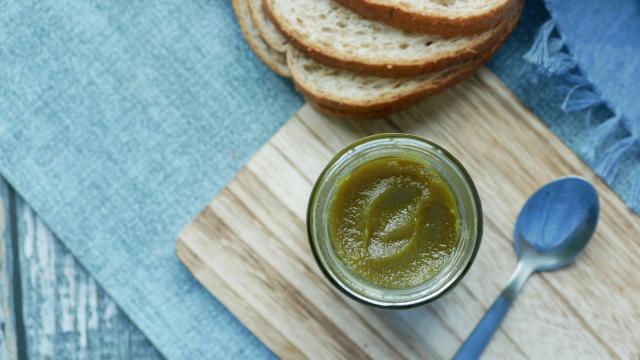Flavourful dips and spreads are some of the greatest gifts I give to myself. Baba ganoush, onion dip, and straight cream cheese all have the ability to elevate anything from a lobster omelette to a pretzel stick. For sweet applications, there’s kaya jam. This queen of coconut condiments pairs well slathered on toast or layered in a cake. Best of all, it’s simple enough to make in your home kitchen.
Kaya jam, at its most elemental, is a coconut custard thickened with egg. It’s thick like lemon curd, sweet without being cloying, has a delicate coconut flavour with notable herbal, grassy notes, and the colour ranges from a toasty brown to emerald green. The grassy notes and the green colour come from a flavorful plant called pandan. This grass is popular in Southeast Asian cuisine and used as a flavouring in a variety of contexts. It’s blended with water and added to desserts as an extract, braised with meats, and wrapped around fish. It’s described as bright, verdant, and sometimes as giving vanilla-vibes. (Read here for more on pandan.)
Depending on where you live, pandan might be available near you. Check the Asian grocery stores in your area for fresh or frozen leaves. You can also order pandan flavouring products online. If you can’t find it, it’s ok. The kaya will still taste delightful, if missing the aromatics. I omit pandan in the following recipe, but you could add a ½ teaspoon of pandan extract or vanilla extract if you want a little somethin’.
The procedure in the following recipe is nearly identical to making lemon curd. If you’ve never done that, read on. Heat the coconut milk (full-fat, please), salt, white sugar, and palm sugar in a medium-sized pot over medium-low heat. Palm sugar is normally in the baking section or international aisle at the grocery store. You can substitute in coconut sugar, or brown sugar if that works best for you, but the flavours are subtly different between these three. Have the egg yolks in a medium bowl ready with a whisk.
Stir the coconut milk mixture with a rubber spatula. Once the edges start to bubble, and visible steam is rising from the pot, turn off the heat and temper the egg yolks with the mixture. Slowly add the hot liquid to the eggs, while simultaneously whisking. This will bring up the temperature without curdling the yolks. Most often, folks pour slowly directly from the pot, or they’ll use a ladle. When you have about 75% of the coconut mixture in with the egg yolks, return it all back to the pot. Turn the heat back on medium-low to low, and constantly stir the mixture with the rubber spatula. It will slowly begin to thicken. It might take between five and ten minutes, but don’t rush it or you could cook the eggs into lumps.
Once the mixture is thick enough to coat the spatula, but not as thick as pudding, you can turn off the heat. Run this mixture through a sieve (if you’re afraid of lumps, but it’s not necessary), and into a bowl. It’s not unusual for the mixture to have something of a textured look, but it should feel smooth when you eat it. Place plastic wrap against the surface to prevent a skin from forming and chill it in the fridge until set, about one to three hours.
Spread this delightful coconut concoction in between two slices of toast with butter for a dish called kaya toast, or add a dollop to your muffin, ice cream, or overnight oats. I know I said I use kaya jam for sweet snacks, but it’s not unusual for kaya toast to be enjoyed in Singapore with soft-boiled eggs and soy sauce. Keep the kaya jam well-covered and stored in the fridge for up to a week.
Pandan-less Kaya Jam
Ingredients:
- ½ can full-fat coconut milk
- 2 tablespoons palm sugar, chopped if solid (substitute coconut sugar or brown sugar)
- ¼ cup white sugar
- Pinch salt
- 4 egg yolks
- 1/2 teaspoon pandan or vanilla extract (optional)
In a medium pot, add the coconut milk, sugars, and salt. Cook over medium-low heat, stirring occasionally with a rubber spatula.
Put the egg yolks in a medium bowl, and whisk them to break them up. Keep the whisk handy. Once the milk mixture begins bubbling along the outer edge and steaming, turn off the heat and temper the yolks. Whisk while simultaneously drizzling the hot coconut milk mixture into the bowl of egg yolks so they come up to temperature. When about 75% of the milk mixture is in with the eggs, return the entire mixture back to the pot.
Turn the burner back on medium-low heat and stir constantly with the rubber spatula. When the mixture is thick enough to coat the spatula, but not as thick as pudding, take it off the heat and stir in the extract (if using). Pour it through a sieve if you think there are lumps, and into a bowl. Cover with plastic wrap touching the surface of the kaya jam. Chill in the fridge until set, about one to three hours.

Leave a Reply
You must be logged in to post a comment.